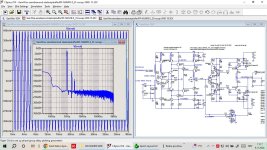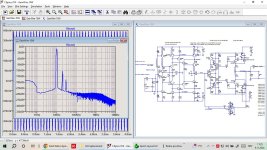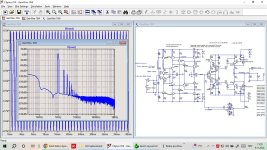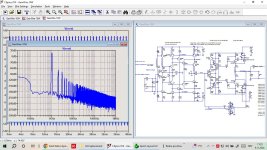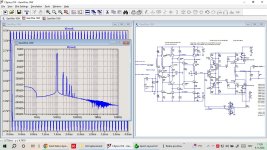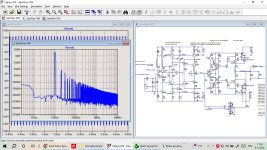You may want to familiarize yourself with multi-tone testing then. That's a quite dynamic signal when you observe it on a scope.ASR-style measurements do not determine sound quality, because music is endlessly dynamic, which confounds easy measurement.
Where I disagree mostly with ASR is in the stacked ranking of equipment. The top, probably, 20 products are all within ±0.1 dB of each other on whatever parameter you choose. That's caused by measurement tolerances and not by differences in the equipment, so it makes no sense to rank them.
I commend Amir of ASR for holding manufacturers accountable for the performance of their products. Sadly, the culture on ASR has become increasingly dogmatic. It's turned into "how many dollars per dB SINAD at 5 W" rather than an audio review site. There's also been quite a few cases now where Amir has been swayed by the manufacturer to recommend their products (Schiit) even though they measured poorly and examples where he's had an error in his test (Emotiva) that wasn't revealed until way down in the thread and not followed up on because he'd shipped the equipment back.
That said, there's a good body of scientific research that shows equipment that measures well is also favoured in blind tests. Similarly, there's research to show that in sighted tests, higher priced gear is rated more highly, a pretty chassis will give a more favourable rating, etc. Humans are not rational critters. Sean Olive and Floyd Toole's work at Harman (accessible via AES) is a good place to start.
To me, good measurements show that some quality engineering went into the circuit design. You don't get -140 dBc THD by accident. You get there by understanding how the components work, the physics that's involved in PCB layout, understanding the circuits, etc.
Tom
In case it isn't obvious, my 'boring' is tongue in cheek. Wannabe Golden Pinnae think low distortion amps boring cosWhy are low distortion amplifiers boring ???
But when tested in DBLTs, they fail to put their favourite Golden Pinnae amps above boring amps without such exciting features 😊Many (all?) Golden Pinnae amps are unstable with certain loads, have loadsa xover and other THD bla bla at times ... all dependent on the signal & thermal history. No wonder they sound 'different'.
The only exception was the little JLH 10W Class A. My guess is it's rather nice Distortion profile .. mostly 2nd at about 0.1% and dropping quickly with level. To prove it, I would have to make another amp with the same Distortion profile but completely different configuration eg a Class B amp. Sadly, I no longer have the facilities to conduct DBLTs to the required accuracy .. let alone my DBLT panel which had some of the best ears in the business.
Last edited:
Got some circuits to share?It is actually rather easy to get .1 or .01% without the heat.
Typical topologies with simplified class A second gain stages.
Do it there not the output stage.
....
Done and heard a zillion spongy 10 watt JLH.
You might want to check out the Distortion profile of your spongy 10W JLH. There were a few other Golden Pinnae Class A amps in our DBLTs but none came out as preferred.
It's real easy to bias a DBLT against the 10W JLH because of its low power. Just make sure it clips a lot
 A lot of the work (and it is a LOT) in conducting proper DBLTs is making sure all DUTs get a fair chance.
A lot of the work (and it is a LOT) in conducting proper DBLTs is making sure all DUTs get a fair chance.For speakers, it meant using a 1000W/channel amp. At the time, there was only one amp of that power which was 'blameless' in all other aspects. Not sure if there is anything like that exists today.
And there were a couple of valve amps which did well too ie highly regarded in DBLTs. These had 'boring' specs 😊
Last edited:
Generally speaking, I see your point, but it starts interesting (to me) and then gradually fades into vagueness (to me).
My mind would need more explanation, more etails, more knowhow, although from what I guess I've realized I agree with you quite a bit, despite never having had your experiences and your experience.
At the end of the day, no one ever buys something without first trying it at home, so what is the problem in the reliability of the listening experiences reported or in personal preferences (if any) that do not necessarily have to please everyone?
You read about a narrative of a listening experience and then, if you were interested in buying that device (of course DIY too) you try to find it and try it.
If you confirm what was reported and you like how it sounds, you buy it, otherwise you return it.
Don't we all do and have always done this?
My point is: why ask (maybe not you here, but in another thread they done) for the 100% reliability and repeatability of what was listened to if not even the measurements tell you how that device sounds?
It probably depends on how you get started with hi-fi.
And someone who only buys is oriented differently than someone who also screws.
A story: I have a friend who started buying everything according to the high rankings in the "HiFi" magazines. And it was a pretty good match. What was the background? In the magazine rankings, increasingly complex devices are collected on one side and the simple, lean things on the other. And it is precisely these two directions in audio: maximization or minimization. But these two do not harmonize. And: with minimalization you can listen to everything, with maximization only "audiophile high-end candlelight blues"-)
Oh, also: nobody will pay much for less - except for things from Paravicini, for example;-)
Another tip for all of us here: leave a listening pause of at least 10 seconds between comparisons. The ideal time is actually the plugging time of two devices. Why? The human organism is a vibrational and electrical context. It needs time to swing in and out. Otherwise even large differences will no longer be audible.
If no or only slight differences can be heard in the devices above, then the method is unsuitable.
You can look here, it is easy to design an transistor amp with distortion profile you like. Here is a preamp but just change OPS and you are there.In case it isn't obvious, my 'boring' is tongue in cheek. Wannabe Golden Pinnae think low distortion amps boring cos
But when tested in DBLTs, they fail to put their favourite Golden Pinnae amps above boring amps without such exciting features 😊
The only exception was the little JLH 10W Class A. My guess is it's rather nice Distortion profile .. mostly 2nd at about 0.1% and dropping quickly with level. To prove it, I would have to make another amp with the same Distortion profile but completely different configuration eg a Class B amp. Sadly, I no longer have the facilities to conduct DBLTs to the required accuracy .. let alone my DBLT panel which had some of the best ears in the business.
This is GW preamp with no global NFB used, in SMD technic and increased output power to drive even low impedance hedphones.
It is dual mono, used separate power supplay per channel.
Output amplifier uses CFP with mosfet transistors and it's powered by capacitanse multiplier incorporating overcurrent and DC offset protection.
Gain block is a current conveyor and it's powered with shunt regulator one per channel.
Damir
It is dual mono, used separate power supplay per channel.
Output amplifier uses CFP with mosfet transistors and it's powered by capacitanse multiplier incorporating overcurrent and DC offset protection.
Gain block is a current conveyor and it's powered with shunt regulator one per channel.
Damir
I don't think quoting john Westgate as some paragon of audio business, is a wise move. He owes a bunch of guys over on pinkfishmedia.net the best part of £100,000 for dac designs we invested in but he never delivered.
Yet in the same time period he's delivered countless designs to manufacturers, many using the headline features we were all suckered into investing by...
Yet in the same time period he's delivered countless designs to manufacturers, many using the headline features we were all suckered into investing by...
Thanks for this Damir. But I don't think your amp quite has the Distortion profile of JLH 10W Class A.You can look here, it is easy to design an transistor amp with distortion profile you like. Here is a preamp but just change OPS and you are there.
This is GW preamp with no global NFB used, in SMD technic and increased output power to drive even low impedance hedphones.
It is dual mono, used separate power supplay per channel.
Output amplifier uses CFP with mosfet transistors and it's powered by capacitanse multiplier incorporating overcurrent and DC offset protection.
Gain block is a current conveyor and it's powered with shunt regulator one per channel.
Damir
Got any THD vs frequency plots at different power levels?
No is the answer to the question asked.
If you believe otherwise, you are thinking past the question.
Enjoy this thread, it will go around that continual boring circle until all the letters of the alphabet have been used at which time...
...we zzzzzzz.
If you believe otherwise, you are thinking past the question.
Enjoy this thread, it will go around that continual boring circle until all the letters of the alphabet have been used at which time...
...we zzzzzzz.
Last edited:
It would be good to know, how it measures in the room, because you could be living a lie.
It is like eating a type of food thinking it is good for you because it was marketed as so, or like cigarettes in the 1960s
Does s.e.t. sounds good, yes! but it has to be matched with faulty old loudspeakers made of paper in the 1940s
Many principles exist , however you have to find what you like and shop a lot. What you want in the end is satisfaction, if you think measuring is going to bring you more information to be able to take better decisions, yes!
Otherwise, I remember at the diy .... convention, someone brought old speakers and was so proud to show it to us!
One member said it doesn't sound right.... he removed the cloth and revealed a woofer which surround was rotten and wobbling without support practically.
I saw the old man expression of total defeat... it was total betrayal and revealing he had no ability to hear whatsoever.
Many many people don't want to know and prefer not to know. ------- cant stress this more
I was also humbled, I brought a dac which didn't impressed anyone, it was not my design, but I tweaked it a lot , solid state based from wolfenson broadcasting station, it was night and day from the stock, but no body was impressed and I could understand why.
What I loved the most is at the end I listened to a restored fisher el34 amp, which was the only thing I heard which I liked.
I wasn't convinced at all listening to all the sabre dacs and hifi headphones setups.
It is like eating a type of food thinking it is good for you because it was marketed as so, or like cigarettes in the 1960s
Does s.e.t. sounds good, yes! but it has to be matched with faulty old loudspeakers made of paper in the 1940s
Many principles exist , however you have to find what you like and shop a lot. What you want in the end is satisfaction, if you think measuring is going to bring you more information to be able to take better decisions, yes!
Otherwise, I remember at the diy .... convention, someone brought old speakers and was so proud to show it to us!
One member said it doesn't sound right.... he removed the cloth and revealed a woofer which surround was rotten and wobbling without support practically.
I saw the old man expression of total defeat... it was total betrayal and revealing he had no ability to hear whatsoever.
Many many people don't want to know and prefer not to know. ------- cant stress this more
I was also humbled, I brought a dac which didn't impressed anyone, it was not my design, but I tweaked it a lot , solid state based from wolfenson broadcasting station, it was night and day from the stock, but no body was impressed and I could understand why.
What I loved the most is at the end I listened to a restored fisher el34 amp, which was the only thing I heard which I liked.
I wasn't convinced at all listening to all the sabre dacs and hifi headphones setups.
Its simple and the obvious is invisable to most men.do you listen with feeling or the intellect.distortion facts and figures are for intellectuals who think they are listening to music and figures somehow will improve your listening exprerience.wrong. emotion is feeling the music as a pleasant experience. Thats why i love my se tube amp.its dounds awsome with 10% distortion.
That is the point. To learn how measurements correlate with sound quality, one way or the other.what measurements correlate with sound? please do tell...
There is always something to be learned, even if you are an old timer.
Perhaps the methodology for measuring what really affects sound quality needs to be improved, especially for power amplifiers.Because i heard lots of amplifiers which measure great but sound like crap.
This is something that I've been very interested in.
Power amplifiers often drive a very complex load with a highly dynamic signal.
Continuous sine waves with a purely resistive load is far from an ideal testing methodology.
now we have the technology to test exactly these complex dynamic signals, with programmable dac and on demand arbitrary waves generators.
I could very easy see the difference in a tube output and a opamp output, however to say why by ear alone is very hard, like why guess there is a tumor when you can see it with MRI?
I could very easy see the difference in a tube output and a opamp output, however to say why by ear alone is very hard, like why guess there is a tumor when you can see it with MRI?
I spent few hours at Capital Audio Festival yesterday, and will attend again today, for I have not finished all the rooms. There is plenty to see and listen to.
Some of the best sounding rooms are using tube amplifiers. Hard to estimate percentage, but it could as many as one third. Same for headphone amplifiers, lots of tubes.
These generally will have higher distortion. Yet exibitors choose them for their sound.
Some of the best sounding rooms are using tube amplifiers. Hard to estimate percentage, but it could as many as one third. Same for headphone amplifiers, lots of tubes.
These generally will have higher distortion. Yet exibitors choose them for their sound.
Regarding JLH: simply remove the bootstrap capacitor and listen. There is a clearly audible difference. And: a device is compared with itself. And: a change of the concept circuit is compared.
Which is why tube devices usually sound "better": not the distortion values but the fewer components and complex circuits that modulate the current and the signal less.
Oh: in the field audio, listening is THE observation, and description, is THE measurement! Further, other measuring methods, such as visual line reproduction and numerical determination are, strictly speaking, inapplicable, serving at best to interpret or assure THE observation and measurement hearing in one direction or another. However, they cannot and must not replace or question hearing as THE observation in field audio.
Which is why tube devices usually sound "better": not the distortion values but the fewer components and complex circuits that modulate the current and the signal less.
Oh: in the field audio, listening is THE observation, and description, is THE measurement! Further, other measuring methods, such as visual line reproduction and numerical determination are, strictly speaking, inapplicable, serving at best to interpret or assure THE observation and measurement hearing in one direction or another. However, they cannot and must not replace or question hearing as THE observation in field audio.
It's like asking someone who is sane and in good faith to establish by sight the acceleration value of a plane during takeoff.
No one will be able to tell you reliably, by sight, and it will take suitable tools to obtain adequate accuracy.
And if you want reliable and accurate results, the same thing will happen for sharing a listening experience, because there are too many variables and uncertainty related to the human factor to obtain results comparable to those of a measuring instrument.
However, there is no measuring instrument that reveals the quality of sound other than our ears.
It seems like an inexorable loop and perhaps it is, but we could also decide to improve the outcome.
Also because, as many have already indicated for some time, discussions of this type have never led to a noteworthy and shared conclusion.
Does this mean that we cannot declare what we listen to?
The fate of this question is in our own hands.
In other words, if we accept the fact that asking the auditory system ears/brain to provide results comparable to those of a measuring instrument is not fair, we put on the same level the fact that not even the most refined measurements will be able to predict how a sound reproduction device sounds.
Rather than a contrast, I see the need for an agreement between the parties.
P. S.: It's like we're thinking almost the same thing at the same time; I wrote this above an hour ago for another thread, but I hadn't posted it yet...
No one will be able to tell you reliably, by sight, and it will take suitable tools to obtain adequate accuracy.
And if you want reliable and accurate results, the same thing will happen for sharing a listening experience, because there are too many variables and uncertainty related to the human factor to obtain results comparable to those of a measuring instrument.
However, there is no measuring instrument that reveals the quality of sound other than our ears.
It seems like an inexorable loop and perhaps it is, but we could also decide to improve the outcome.
Also because, as many have already indicated for some time, discussions of this type have never led to a noteworthy and shared conclusion.
Does this mean that we cannot declare what we listen to?
The fate of this question is in our own hands.
In other words, if we accept the fact that asking the auditory system ears/brain to provide results comparable to those of a measuring instrument is not fair, we put on the same level the fact that not even the most refined measurements will be able to predict how a sound reproduction device sounds.
Rather than a contrast, I see the need for an agreement between the parties.
P. S.: It's like we're thinking almost the same thing at the same time; I wrote this above an hour ago for another thread, but I hadn't posted it yet...
Last edited:
Here is an ClassA amp to be 10W on 8ohm, JLH 10W replacement. not so simple but without GNFB. Look the FFTs.Thanks for this Damir. But I don't think your amp quite has the Distortion profile of JLH 10W Class A.
Got any THD vs frequency plots at different power levels?
Attachments
That's not surprising as both power & THD is VERY badly affected by removing the bootstrap capacitor. Of course you might prefer an amp that overloads more often and has more distortion overall.Regarding JLH: simply remove the bootstrap capacitor and listen. There is a clearly audible difference. And: a device is compared with itself. And: a change of the concept circuit is compared.
Yes. But the correct measurement is a DBLT and the instrument is your DBLT panel. Like all instruments, you need to check & calibrate it every now & then. If you spend some time & effort to do this, you rapidly find certain important FACTS. egOh: in the field audio, listening is THE observation, and description, is THE measurement!
- Da wannabe Golden Pinnae who hear differences between mains cables bla bla are DEAF (Give random results in DBLTs)
- HiFi Reviewers are less perceptive than the man in the street. There a VERY few exceptions
- The woman in the street is generally more perceptive than the man in the street ... so pay attention if your girlfriend, mistress, wife or mother says, "I don't like this new one as much as your old one."
- Even the best ears in the business are biased & opinionated so I put loads more importance on their opinion blind than sighted.
- Surprisingly, when you weed out the deaf Wannabe Golden Pinnae and find the true golden ears who can pick out small differences, they ALL prefer the same stuff in DBLTs. Applies to hard rock aficionadoes, classical musicians, recording engineers, speaker designers ... from teenage girls to those designing their own microphones who insist on using their own recordings to judge stuff
No point designing gear to suit the ears of the wannabe Golden Pinnae cos they are deaf. Instead you tell them loudly & clearly that your stuff is hand carved from Unobtainium and solid BS by Virgins 😊
Last edited:
To get what?Yes. But the correct measurement is a DBLT and the instrument is your DBLT panel.
Of course, I'm not trolling at all, since I really wonder, if it's true that two equal brains do not exist then what's the point of the tests?
It's not at all certain that the first ranked device must sound equally good in my system.
I'll have to try it in every case before buying it.
I might like it or not like it for an infinite number of more or less realistic reasons.
So what changes compared to the listening description of a member of this forum?
It wants to be what it is: the listening description of a member of this forum of a device that he has listened to or built.
And I'll have to try it before buying or building it in any case.
So please someone explain to me what's the point of the perfectly executed double-blind tests even with a very high percentage of "preferences" since I can't get there on my own.
I'm wondering whether that's an appropriate comparison. The flight train during acceleration is like the volume turn up measurement: zero statement.It's like asking someone who is sane and in good faith to establish by sight the acceleration value of a plane during takeoff.
No one will be able to tell you reliably, by sight, and it will take suitable tools to obtain adequate accuracy.
And if you want reliable and accurate results, the same thing will happen for sharing a listening experience, because there are too many variables and uncertainty related to the human factor to obtain results comparable to those of a measuring instrument.
However, there is no measuring instrument that reveals the quality of sound other than our ears.
It seems like an inexorable loop and perhaps it is, but we could also decide to improve the outcome.
Also because, as many have already indicated for some time, discussions of this type have never led to a noteworthy and shared conclusion.
Does this mean that we cannot declare what we listen to?
The fate of this question is in our own hands.
In other words, if we accept the fact that asking the auditory system ears/brain to provide results comparable to those of a measuring instrument is not fair, we put on the same level the fact that not even the most refined measurements will be able to predict how a sound reproduction device sounds.
Rather than a contrast, I see the need for an agreement between the parties.
P. S.: It's like we're thinking almost the same thing at the same time; I wrote this above an hour ago for another thread, but I hadn't posted it yet...
Precisely because we hear and are put into moods, swinging by hearing, i.e. highly complex processes that are individually different, we cannot currently limit anything to a few highly excerpted, decontextualized values. I think we could compare it to a television: its images also set the mood, swinging. And here too, distinctions can be made: which film is playing, which genre, but also the "technical" characteristics: is the picture clear, colorful, authentic, does it have shadows in the course, how high is the resolution, the level of detail, how large is the picture, how far away do I have to sit and what do I know. These "technical" characteristics also influence the perception of the movie shown. The majority here will certainly prefer a high-resolution LED screen to an old small tube tv most time. And it is by no means possible to determine or predict the picture quality, including progression and speed, using lines and numbers. You have to turn on the TV, watch the movies and get in the mood, swinging;-)
- Status
- Not open for further replies.
- Home
- Member Areas
- The Lounge
- If you like it, does it matter how it measures
